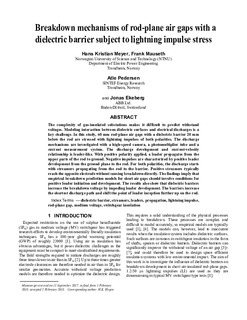Breakdown Mechanisms of Rod-Plane Air Gaps with a Dielectric Barrier Subject to Lightning Impulse Stress
Journal article, Peer reviewed
Accepted version
Permanent lenke
http://hdl.handle.net/11250/2558278Utgivelsesdato
2018Metadata
Vis full innførselSamlinger
- Institutt for elkraftteknikk [2410]
- Publikasjoner fra CRIStin - NTNU [37169]
Originalversjon
IEEE transactions on dielectrics and electrical insulation. 2018, 25 (3), 1121-1127. 10.1109/TDEI.2018.007023Sammendrag
The complexity of gas-insulated substations makes it difficult to predict withstand voltages. Modeling interaction between dielectric surfaces and electrical discharges is a key challenge. In this study, 60 mm rod-plane air gaps with a dielectric barrier 20 mm below the rod are stressed with lightning impulses of both polarities. The discharge mechanisms are investigated with a high-speed camera, a photomultiplier tube and a current measurement system. The discharge development and current-velocity relationship is leader-like. With positive polarity applied, a leader propagates from the upper parts of the rod to ground. Negative impulses are characterized by positive leader development from the ground plane to the rod. For both polarities, the discharge starts with streamers propagating from the rod to the barrier. Positive streamers typically reach the opposite electrode without causing breakdown directly. The findings imply that empirical breakdown prediction models for short air gaps should involve conditions for positive leader initiation and development. The results also show that dielectric barriers increase the breakdown voltage by impeding leader development. The barriers increase the shortest discharge path and shift the point of leader inception further up on the rod.
